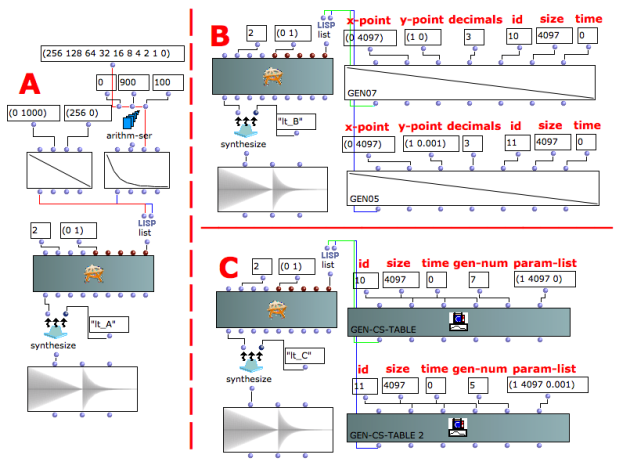Local tables
Local tables are tables passed to an input of a OMChroma class whose name ends with "env". These inputs are not processed polymorphically in the same way as explained in the tutorial 12-Slot-polymorphism. These inputs are considered to have a different kind of structures, that will be converted into GEN instructions in Csound (see the Csound manual for a complete explanation of GEN functions).
Tutorial Local Tables
This patch shows three different ways of specifying local tables in OMChroma. In these examples, the tables are the amplitude envelopes of an add-1 class.
Example A
The tables are passed to the add-1 class as a BPF class. These tables will be converted into a GEN routine of type 7 (linear break-point function) for each element of the event, starting with the f1000 by default. As a consequence, each element will have its own GEN function, even if the data are the same.
NB: Since the table will rescaled between 0 and 1, the absolute size of the numbers is not important.
WARNING: BPF's are initialized with a decimal precision (last input on the right) of 0. This means, that only integer numbers are considered, and that floating point numbers will not be taken into account (only the digit before the comma will be used). To avoid this, improve the decimal precision by changing 0 into a larger number (5 to 7 are recommended).
Example B
The tables are passed to the add-1 class as GEN07 (linear break-point function) and GEN05 (exponential break-point functions) classes. These are specialized classes that directly correspond the the equivalent Csound GEN routines. Notice that one can specify a GEN05, that is a table with an exponential interpolation between the segments, whereas, when passing a BPF, the BPF will be always converted into a GEN07 routine.
WARNING 1: GEN05, being exponential, cannot have a point = 0 (as exponential interpolations do not go to 0). As a consequence, unless a more elaborated orchestra is used, a GEN05 used as an amplitude envelope will produce a (probably small) click at the end of the sound.
WARNING 2: the y-values of these classes are rescaled between 0 and 1 by Csound. There exist also the classes GEN-05 and GEN-07, where the values are not rescaled (negative type number, see below and the Csound documentation).
Example C
The tables use the class GEN-CS-TABLE. This class allows to specify any type of GEN routine (not only the types 5 and 7 used here). The type is given in the input gen-num, while the number of the table is specified in the input id. The param-list (last input on the right) will then have to exactly correspond to the format required by Csound, as no conversion will be done in this case (see Warning below).
In Csound, the break-point GEN routines (type 5 and 7) have a specific syntax that obeys to the following rule: y1 dx1 y2 dx2... yN, where:
yX = value of the Y-axis. Is the GEN type is positive (ex. 7), the values will be rescaled between 0.0 and 1.0, if the GEN type is negative (ex. -7), no rescaling will be performed.
dxX = distance (in points) between yX-1 and yX (NOT the absolute value of the X axis). All the distances should sum up to the value specified by size. If the sum is too large, the table will be truncated, if it is too small, the table will be zero padded.
Notice that the size of the GEN routines type 5 and 7 MUST be equal to a POWER OF 2 + 1.
Using BPFs only the data will be passed to the GEN routine and a GEN of type 7 (linear break-point function) will be used.

